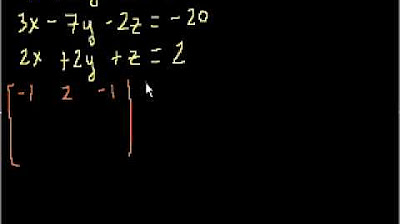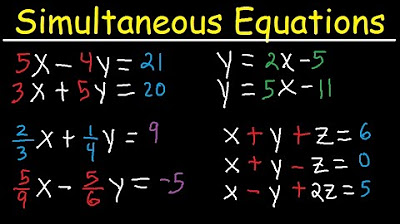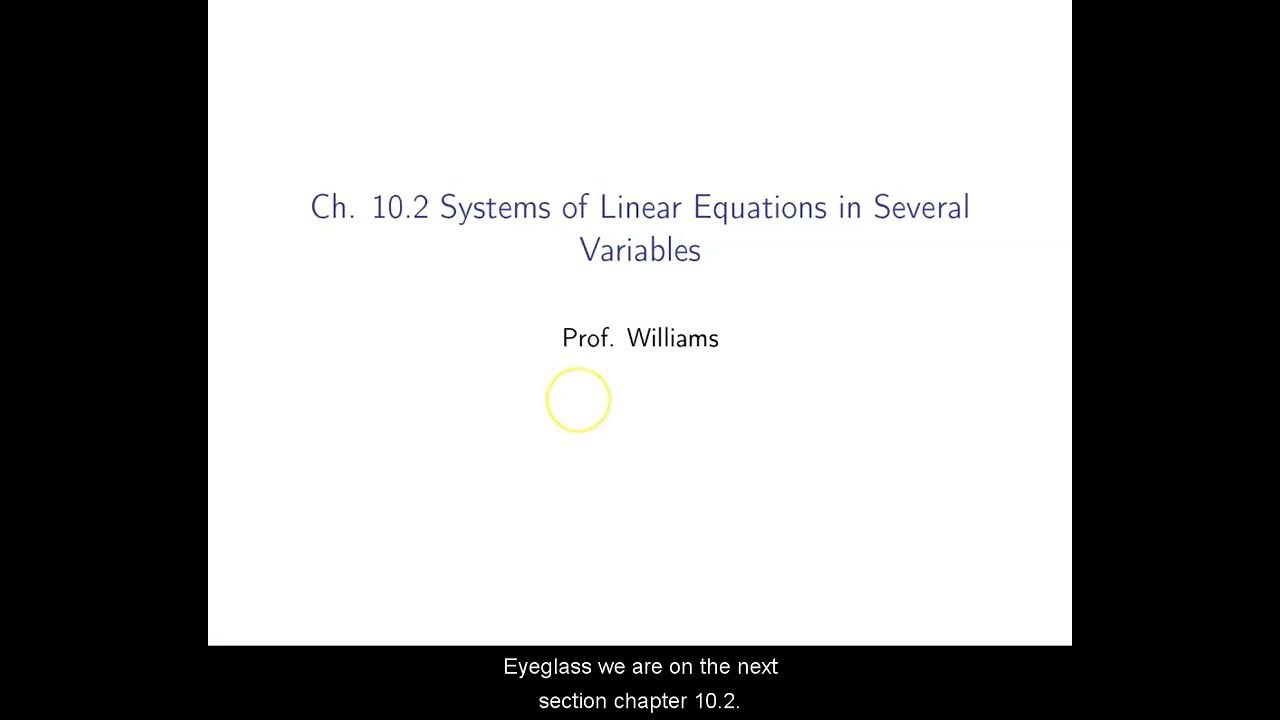SOLVING SYSYEM OF NONLINEAR EQUATIONS || PRECALCULUS
TLDRThis video lesson dives into solving systems of non-linear equations using three primary methods: substitution, elimination, and graphing. The instructor begins with the substitution method, illustrating how to solve for variables in a system like y = -x + 2 and x^2 + y = 2. The elimination method is then showcased, demonstrating how to eliminate variables algebraically to find solutions, using an example system involving x and y squared terms. Lastly, the graphing method is introduced, explaining how to visualize and solve non-linear systems by plotting them on a graph, which is particularly useful for systems that represent geometric shapes like circles and ellipses. The video serves as a comprehensive guide for learners to understand and apply these mathematical techniques.
Takeaways
- 📚 The video lesson covers solving systems of non-linear equations using three methods: substitution, elimination, and graphing.
- 🔍 The substitution method involves expressing one variable in terms of another and substituting it into the other equation.
- 📐 In the elimination method, equations are manipulated to cancel out one of the variables, making it easier to solve for the other.
- 📈 The graphing method involves plotting the equations on a graph and finding the points of intersection, which are the solutions.
- 🔑 The first example uses the substitution method to solve the system: y = -x + 2 and x^2 + y = 2, resulting in solutions (0, 2) and (1, 1).
- 🧩 The second example demonstrates the substitution method with the system: x^2 + y^2 = 10 and x - 3y = -10, leading to the solution (-1, 3).
- ✂️ The elimination method is shown with the system: x^2 - 6x + y^2 + 2y = 15 and x^2 - 6x - 2y = 3, resulting in solutions (3, -6), (7, 2), and (-1, 2).
- 📉 An example of graphing involves transforming the equations into standard form to identify them as a circle and an ellipse, then finding their intersection points.
- 📝 The video emphasizes the importance of understanding the different methods for solving non-linear systems and when to apply each one.
- 🎓 The lesson aims to educate viewers on mathematical problem-solving techniques, encouraging them to practice and apply these methods.
- 👨🏫 The instructor guides the viewers through each step of the process, from understanding the equations to finding the solutions.
Q & A
What are the three methods discussed in the video for solving systems of non-linear equations?
-The video discusses the substitution method, elimination method, and graphing method for solving systems of non-linear equations.
How does the substitution method work in the context of the given example where y = -x + 2 and x^2 + y = 2?
-In the substitution method, you substitute the value of y from the first equation into the second equation. Here, substituting y = -x + 2 into x^2 + y = 2 gives x^2 - x + 2 = 2, which simplifies to x^2 - x = 0. Factoring out x gives x(x - 1) = 0, so the solutions for x are 0 and 1.
What are the solutions for x and y when using the substitution method with the equations y = -x + 2 and x^2 + y = 2?
-The solutions are x = 0, y = 2 and x = 1, y = 1. These are found by substituting the values of x back into the equation for y.
What is the process of solving the system of equations x^2 + y^2 = 10 and x - 3y = -10 using the substitution method?
-First, express x in terms of y from the second equation: x = 3y - 10. Then substitute this expression into the first equation to get (3y - 10)^2 + y^2 = 10. Expanding and simplifying this equation will help find the values of y, which can then be substituted back to find the corresponding x values.
How do you solve for y in the system x^2 + y^2 = 10 and x - 3y = -10 after substituting x with 3y - 10?
-After substituting, you get (3y - 10)^2 + y^2 = 10. Expanding this gives 9y^2 - 60y + 100 + y^2 = 10. Simplifying leads to 10y^2 - 60y + 90 = 0. Dividing by 10 gives y^2 - 6y + 9 = 0, which factors to (y - 3)(y - 3) = 0, so y = 3.
What are the solutions for x and y in the system x^2 + y^2 = 10 and x - 3y = -10?
-The solution is x = -1 and y = 3, found by substituting y = 3 into x = 3y - 10.
What is the elimination method and how does it apply to the system x^2 - 6x + y^2 + 2y = 15 and x^2 - 6x - 2y = 3?
-The elimination method involves adding or subtracting equations to eliminate one variable. For these equations, subtracting the second from the first eliminates x, resulting in y^2 + 4y + 12 = 0, which can be factored and solved for y.
What are the solutions for x and y in the system x^2 - 6x + y^2 + 2y = 15 and x^2 - 6x - 2y = 3 using the elimination method?
-The solutions are x = 3, y = -6; x = 7, y = 2; and x = -1, y = 2, found by solving the resulting equations after elimination.
How does the graphing method help in solving the system x^2 + y^2 - 6x - 2y = 6 and x^2 + 4y^2 - 6x - 8y = 51?
-The graphing method involves plotting the equations on a graph to find their intersection points. The first equation represents a circle and the second an ellipse. Their intersection points give the solutions to the system.
What are the standard forms of the equations representing a circle and an ellipse in the system x^2 + y^2 - 6x - 2y = 6 and x^2 + 4y^2 - 6x - 8y = 51?
-The standard form of the circle is (x - 3)^2 + (y - 1)^2 = 16, and the standard form of the ellipse is (x - 3)^2/64 + (y - 1)^2/16 = 1.
How can you find the intersection points of a circle and an ellipse represented by the equations x^2 + y^2 - 6x - 2y = 6 and x^2 + 4y^2 - 6x - 8y = 51?
-By graphing both the circle and the ellipse, you can visually identify the points where they intersect. These points are the solutions to the system of equations.
Outlines
📚 Introduction to Solving Non-Linear Equations
This paragraph introduces the topic of solving systems of non-linear equations. The video will cover three methods: substitution, elimination, and graphing. The first example provided is a substitution method where the equation y = -x + 2 is used to solve the system x^2 + y = 2. The process involves substituting the expression for y into the second equation, simplifying, and solving for x. The solutions are found to be x = 0, y = 2 and x = 1, y = 1.
🔍 Substitution Method in Detail
The second paragraph delves deeper into the substitution method by providing another example. The system x - 3y = -10 and x^2 + y^2 = 10 is solved by expressing x in terms of y and substituting it into the second equation. After simplification, the equation is reduced to a quadratic form in y, which is then solved to find y = 3. Subsequently, x is found to be -1, resulting in the solution (-1, 3) for the system.
🚫 Elimination Method for Non-Linear Systems
The third paragraph discusses the elimination method applied to a system of equations. The given system x^2 - 6x + y^2 + 2y = 15 and x^2 - 6x - 2y = 3 is manipulated to eliminate like terms, resulting in a new equation y^2 + 4y - 12 = 0. Solving this, y is found to be either -6 or 2. Substituting these values back into the original equations yields the corresponding x values, resulting in three possible solutions: (3, -6), (7, 2), and (-1, 2).
📈 Graphing Method and Standard Equations
In the fourth paragraph, the graphing method is introduced alongside the concept of standard equations. The system x^2 + y^2 - 6x - 2y = 6 and x^2 + 4y^2 - 6x - 8y = 51 is transformed into the standard form of a circle and an ellipse, respectively. The center and radius of the circle, as well as the center and axes of the ellipse, are identified. The intersection points of these geometric shapes represent the solutions to the system of equations.
👋 Conclusion and Call to Action
The final paragraph concludes the video lesson by summarizing the methods taught: substitution, elimination, and graphing for solving systems of non-linear equations. The presenter thanks the viewers for watching and encourages them to like, subscribe, and hit the bell for more video tutorials. The channel aims to be a guide for learning and mastering mathematical lessons.
Mindmap
Keywords
💡System of Non-linear Equations
💡Substitution Method
💡Elimination Method
💡Graphing Method
💡Factoring
💡Circle
💡Ellipse
💡Center
💡Radius
💡Axis
Highlights
Introduction to solving systems of non-linear equations using substitution, elimination, and graphing methods.
Application of the substitution method with the given equations y = -x + 2 and x^2 + y = 2.
Finding the value of y when x = 0 and solving for x by substituting y in the equation.
Solving for x by factoring x^2 - x = 0 and finding x = 0 and x = 1 as solutions.
Determining corresponding y values for each x solution, resulting in (0, 2) and (1, 1).
Using the substitution method for the system x^2 + y^2 = 10 and x - 3y = -10.
Substituting x = 3y - 10 into the equation and simplifying to find y.
Solving the quadratic equation y^2 - 6y + 9 = 0 to find y = 3.
Finding x when y = 3 by substituting back into the equation, resulting in x = -1.
Introduction to the elimination method for solving systems of non-linear equations.
Eliminating variables by adding or subtracting equations to simplify the system.
Solving the system x^2 - 6x + y^2 + 2y = 15 and x^2 - 6x - 2y = 3 using elimination.
Finding y values by factoring and solving the simplified equation y^2 + 4y - 12 = 0.
Determining y = -6 and y = 2 from the factored form and substituting back to find x.
Solving for x when y = -6 and y = 2, resulting in x = 3, x = 7, and x = -1.
Introduction to the graphing method for visualizing and solving systems of non-linear equations.
Transforming the system x^2 + y^2 - 6x - 2y = 6 and x^2 + 4y^2 - 6x - 8y = 51 into standard form.
Identifying the equations as representing a circle and an ellipse and their respective centers and radii.
Graphical representation of the intersection points of the circle and ellipse.
Conclusion summarizing the three methods: substitution, elimination, and graphing for solving non-linear systems.
Transcripts
Browse More Related Video

Solving 3 Equations with 3 Unknowns

Substitution Method For Solving Systems of Linear Equations, 2 and 3 Variables, Algebra 2

Solving Systems of Equations By Elimination & Substitution With 2 Variables

Simultaneous Equations - Tons of Examples!

Solving Systems of Equations By Graphing

Ch. 10.2 Systems of Linear Equations in Several Variables
5.0 / 5 (0 votes)
Thanks for rating: